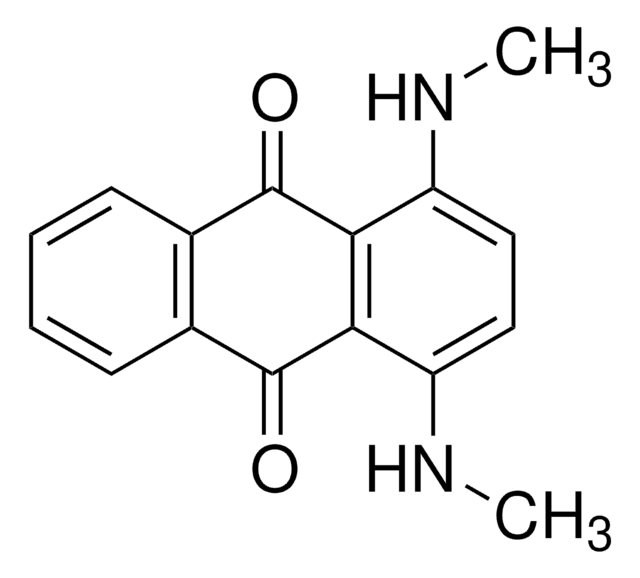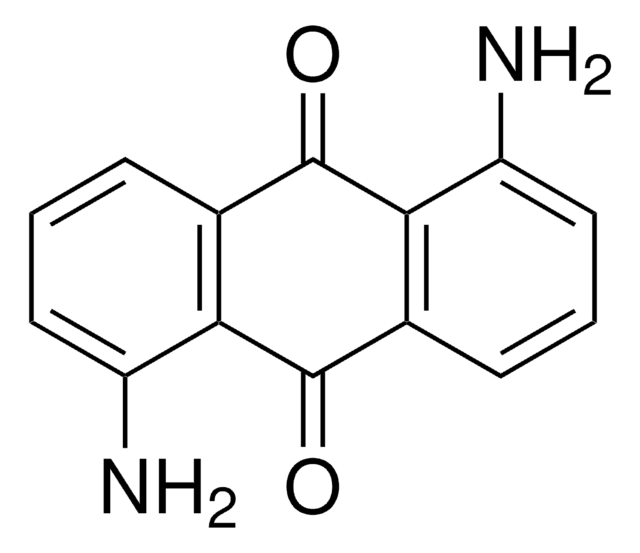모든 사진(2)
About This Item
실험식(Hill 표기법):
C14H12N4O2
CAS Number:
Molecular Weight:
268.27
색상 지수 번호:
64500
Beilstein:
925672
EC Number:
MDL number:
UNSPSC 코드:
12171500
PubChem Substance ID:
NACRES:
NA.47
추천 제품
형태
powder
구성
Dye content, 30%
mp
332 °C
solubility
1 M NH4OH: 10 mg/mL, opaque, blue
λmax
607 nm
응용 분야
diagnostic assay manufacturing
hematology
histology
저장 온도
room temp
SMILES string
Nc1ccc(N)c2C(=O)c3c(N)ccc(N)c3C(=O)c12
InChI
1S/C14H12N4O2/c15-5-1-2-6(16)10-9(5)13(19)11-7(17)3-4-8(18)12(11)14(10)20/h1-4H,15-18H2
InChI key
JSFUMBWFPQSADC-UHFFFAOYSA-N
유사한 제품을 찾으십니까? 방문 제품 비교 안내
일반 설명
Disperse Blue 1 is a grey to black powder. Disperse dyes are known to be insoluble in water and are applied to the substrate as suspensions or dispersions by dissolving in hydrophobic regions of the polymers making up the fiber.
신호어
Danger
유해 및 위험 성명서
Hazard Classifications
Carc. 1B - Eye Dam. 1 - Skin Irrit. 2 - Skin Sens. 1
Storage Class Code
6.1C - Combustible acute toxic Cat.3 / toxic compounds or compounds which causing chronic effects
WGK
WGK 3
Flash Point (°F)
Not applicable
Flash Point (°C)
Not applicable
개인 보호 장비
Eyeshields, Faceshields, Gloves, type P3 (EN 143) respirator cartridges
이미 열람한 고객
A Cruz et al.
Water science and technology : a journal of the International Association on Water Pollution Research, 44(4), 159-166 (2001-09-29)
A sequential anaerobic/aerobic treatment process was used to biodegrade the azo dye disperse blue 79 (DB79). The integrated process was successfully tested and operated for the mineralization of the DB79 dye until a concentration of 120 mg/l in 96 h.
Disperse Blue 1.
IARC monographs on the evaluation of carcinogenic risks to humans, 48, 139-148 (1990-01-01)
Nat. Toxicology Program
Report on Carcinogens (12th Ed. ) (2011)
C M Burnett et al.
Food and chemical toxicology : an international journal published for the British Industrial Biological Research Association, 24(4), 269-276 (1986-04-01)
Disperse Blue 1 (containing 50% lignosulphonate dispersants) was fed to Fischer 344 rats at dietary levels of 0.01 and 0.1% for 19 months and at 1.0% for 6 months. Fischer 344 rats were also given the dye by gavage at
Jeffrey J Yourick et al.
Toxicology and applied pharmacology, 195(3), 309-320 (2004-03-17)
Recent international guidelines for the conduct of in vitro skin absorption studies put forward different approaches for addressing the status of chemicals remaining in the stratum corneum and epidermis/dermis at the end of a study. The present study investigated the
자사의 과학자팀은 생명 과학, 재료 과학, 화학 합성, 크로마토그래피, 분석 및 기타 많은 영역을 포함한 모든 과학 분야에 경험이 있습니다..
고객지원팀으로 연락바랍니다.











